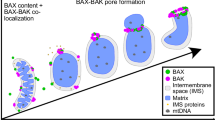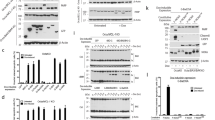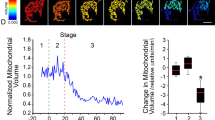Abstract
Among the members of the Bcl-2 family, the multidomain proteins Bax and Bak are crucial for the activation of mitochondria. However, it is still unclear whether they act in a unique and distinct manner or whether they exhibit redundant functions. To systematically investigate their activation on a single-cell level, we established MCF-7 cell lines stably expressing GFP-fusion variants of these proteins. We found that MCF-7/GFP-Bak cells showed an increased sensitivity to apoptosis induction by staurosporine, actinomycin D, TRAIL and overexpression of Puma compared to GFP-Bax-expressing cells. Independently of the death stimulus used, oligomerization of endogenous and exogenous Bak was mostly detected prior to an activation of Bax, whereas cells displaying oligomerized Bax in the absence of Bak clusters were not observed. In addition, activation of Bax but not Bak was attenuated by a caspase inhibitor. Consistent with this, caspase-3-deficient MCF-7 cells displayed a significantly reduced activation of endogenous Bax than caspase-3-proficient MCF-7 cells. Thus, our data strongly suggest that diverse apoptotic stimuli preferentially engage the Bak pathway, whereas the triggering of Bax occurs, at least partially, downstream of mitochondrial caspase activation, most likely constituting a positive feedback loop for the amplification of the death signal.
This is a preview of subscription content, access via your institution
Access options
Subscribe to this journal
Receive 50 print issues and online access
$259.00 per year
only $5.18 per issue
Buy this article
- Purchase on Springer Link
- Instant access to full article PDF
Prices may be subject to local taxes which are calculated during checkout






Similar content being viewed by others
References
Adams JM, Cory S . (1998). The Bcl-2 protein family: arbiters of cell survival. Science 281: 1322–1326.
Adams KW, Cooper GM . (2007). Rapid turnover of mcl-1 couples translation to cell survival and apoptosis. J Biol Chem 282: 6192–6200.
Blanc C, Deveraux QL, Krajewski S, Jänicke RU, Porter AG, Reed JC et al. (2000). Caspase-3 is essential for procaspase-9 processing and cisplatin-induced apoptosis of MCF-7 breast cancer cells. Cancer Res 60: 4386–4390.
Breckenridge DG, Germain M, Mathai JP, Nguyen M, Shore GC . (2003). Regulation of apoptosis by endoplasmic reticulum pathways. Oncogene 22: 8608–8618.
Cartron PF, Juin P, Oliver L, Martin S, Meflah K, Vallette FM . (2003). Nonredundant role of Bax and Bak in Bid-mediated apoptosis. Mol Cell Biol 23: 4701–4712.
Certo M, Del Gaizo Moore V, Nishino M, Wei G, Korsmeyer S, Armstrong SA et al. (2006). Mitochondria primed by death signals determine cellular addiction to antiapoptotic BCL-2 family members. Cancer Cell 9: 351–365.
Chen L, Willis SN, Wei A, Smith BJ, Fletcher JI, Hinds MG et al. (2005). Differential targeting of prosurvival Bcl-2 proteins by their BH3-only ligands allows complementary apoptotic function. Mol Cell 17: 393–403.
Cheng EH, Kirsch DG, Clem RJ, Ravi R, Kastan MB, Bedi A et al. (1997). Conversion of Bcl-2 to a Bax-like death effector by caspases. Science 278: 1966–1968.
Daniel PT, Schulze-Osthoff K, Belka C, Guner D . (2003). Guardians of cell death: the Bcl-2 family proteins. Essays Biochem 39: 73–88.
Dansen TB, Whitfield J, Rostker F, Brown-Swigart L, Evan GI . (2006). Specific requirement for Bax, not Bak, in Myc-induced apoptosis and tumor suppression in vivo. J Biol Chem 281: 10890–10895.
Essmann F, Engels IH, Totzke G, Schulze-Osthoff K, Jänicke RU . (2004). Apoptosis resistance of MCF-7 breast carcinoma cells to ionizing radiation is independent of p53 and cell cycle control but caused by the lack of caspase-3 and a caffeine-inhibitable event. Cancer Res 64: 7065–7072.
Gillissen B, Essmann F, Graupner V, Starck L, Radetzki S, Dorken B et al. (2003). Induction of cell death by the BH3-only Bcl-2 homolog Nbk/Bik is mediated by an entirely Bax-dependent mitochondrial pathway. EMBO J 22: 3580–3590.
Han J, Goldstein LA, Gastman BR, Rabinovitz A, Wang GQ, Fang B et al. (2004). Differential involvement of Bax and Bak in TRAIL-mediated apoptosis of leukemic T cells. Leukemia 18: 1671–1680.
Hsu YT, Wolter KG, Youle RJ . (1997). Cytosol-to-membrane redistribution of Bax and Bcl-X(L) during apoptosis. Proc Natl Acad Sci USA 94: 3668–3672.
Jänicke RU, Sprengart ML, Wati MR, Porter AG . (1998). Caspase-3 is required for DNA fragmentation and morphological changes associated with apoptosis. J Biol Chem 273: 9357–9360.
Kepp O, Rajalingam K, Kimmig S, Rudel T . (2007). Bak and Bax are non-redundant during infection- and DNA damage-induced apoptosis. EMBO J 26: 825–834.
Kim H, Rafiuddin-Shah M, Tu HC, Jeffers JR, Zambetti GP, Hsieh JJ et al. (2006). Hierarchical regulation of mitochondrion-dependent apoptosis by BCL-2 subfamilies. Nat Cell Biol 8: 1348–1358.
Konopleva M, Contractor R, Tsao T, Samudio I, Ruvolo PP, Kitada S et al. (2006). Mechanisms of apoptosis sensitivity and resistance to the BH3 mimetic ABT-737 in acute myeloid leukemia. Cancer Cell 10: 375–388.
Kroemer G, Reed JC . (2000). Mitochondrial control of cell death. Nat Med 6: 513–519.
Lakhani SA, Masud A, Kuida K, Porter Jr GA, Booth CJ, Mehal WZ et al. (2006). Caspases 3 and 7: key mediators of mitochondrial events of apoptosis. Science 311: 847–851.
Letai A, Bassik MC, Walensky LD, Sorcinelli MD, Weiler S, Korsmeyer SJ . (2002). Distinct BH3 domains either sensitize or activate mitochondrial apoptosis, serving as prototype cancer therapeutics. Cancer Cell 2: 183–192.
Letai A . (2005). Pharmacological manipulation of Bcl-2 family members to control cell death. J Clin Invest 115: 2648–2655.
Lindenboim L, Kringel S, Braun T, Borner C, Stein R . (2005). Bak but not Bax is essential for Bcl-xS-induced apoptosis. Cell Death Differ 12: 713–723.
Lindsten T, Ross AJ, King A, Zong WX, Rathmell JC, Shiels HA et al. (2000). The combined functions of proapoptotic Bcl-2 family members bak and bax are essential for normal development of multiple tissues. Mol Cell 6: 1389–1399.
Lomonosova E, Subramanian T, Chinnadurai G . (2002). Requirement of BAX for efficient adenovirus-induced apoptosis. J Virol 76: 11283–11290.
Lucken-Ardjomande S, Martinou JC . (2005). Newcomers in the process of mitochondrial permeabilization. J Cell Sci 118: 473–483.
Micheau O, Tschopp J . (2003). Induction of TNF receptor I-mediated apoptosis via two sequential signaling complexes. Cell 114: 181–190.
Murphy BM, Creagh EM, Martin SJ . (2004). Interchain proteolysis, in the absence of a dimerization stimulus, can initiate apoptosis-associated caspase-8 activation. J Biol Chem 279: 36916–36922.
Oltersdorf T, Elmore SW, Shoemaker AR, Armstrong RC, Augeri DJ, Belli BA et al. (2005). An inhibitor of Bcl-2 family proteins induces regression of solid tumours. Nature 435: 677–681.
Panaretakis T, Pokrovskaja K, Shoshan MC, Grander D . (2002). Activation of Bak, Bax, and BH3-only proteins in the apoptotic response to doxorubicin. J Biol Chem 277: 44317–44326.
Pardo J, Urban C, Galvez EM, Ekert PG, Muller U, Kwon-Chung J et al. (2006). The mitochondrial protein Bak is pivotal for gliotoxin-induced apoptosis and a critical host factor of Aspergillus fumigatus virulence in mice. J Cell Biol 174: 509–519.
Pastorino JG, Shulga N, Hoek JB . (2002). Mitochondrial binding of hexokinase II inhibits Bax-induced cytochrome c release and apoptosis. J Biol Chem 277: 7610–7618.
Perez D, White E . (2000). TNF-alpha signals apoptosis through a bid-dependent conformational change in Bax that is inhibited by E1B 19K. Mol Cell 6: 53–63.
Pop C, Timmer J, Sperandio S, Salvesen GS . (2006). The apoptosome activates caspase-9 by dimerization. Mol Cell 22: 269–275.
Reed JC . (2006). Proapoptotic multidomain Bcl-2/Bax-family proteins: mechanisms, physiological roles, and therapeutic opportunities. Cell Death Differ 13: 1378–1386.
Schulze-Osthoff K, Ferrari D, Los M, Wesselborg S, Peter ME . (1998). Apoptosis signaling by death receptors. Eur J Biochem 254: 439–459.
Schwerk C, Schulze-Osthoff K . (2005). Regulation of apoptosis by alternative pre-mRNA splicing. Mol Cell 19: 1–13.
Shimazu T, Degenhardt K, Nur EKA, Zhang J, Yoshida T, Zhang Y et al. (2007). NBK/BIK antagonizes MCL-1 and BCL-XL and activates BAK-mediated apoptosis in response to protein synthesis inhibition. Genes Dev 21: 929–941.
Sohn D, Schulze-Osthoff K, Jänicke RU . (2005). Caspase-8 can be activated by interchain proteolysis without receptor-triggered dimerization during drug-induced apoptosis. J Biol Chem 280: 5267–5273.
Suzuki M, Youle RJ, Tjandra N . (2000). Structure of Bax: coregulation of dimer formation and intracellular localization. Cell 103: 645–654.
van Delft MF, Wei AH, Mason KD, Vandenberg CJ, Chen L, Czabotar PE et al. (2006). The BH3 mimetic ABT-737 targets selective Bcl-2 proteins and efficiently induces apoptosis via Bak/Bax if Mcl-1 is neutralized. Cancer Cell 10: 389–399.
Wang GQ, Gastman BR, Wieckowski E, Goldstein LA, Gambotto A, Kim A et al. (2001). A role for mitochondrial Bak in apoptotic response to anticancer drugs. J Biol Chem 276: 34307–34317.
Waterhouse NJ, Ricci JE, Green DR . (2002). And all of a sudden it's over: mitochondrial outer-membrane permeabilization in apoptosis. Biochimie 84: 113–121.
Wei MC, Zong WX, Cheng EH, Lindsten T, Panoutsakopoulou V, Ross AJ et al. (2001). Proapoptotic BAX and BAK: a requisite gateway to mitochondrial dysfunction and death. Science 292: 727–730.
Werner AB, de Vries E, Tait SW, Bontjer I, Borst J . (2002). TRAIL receptor and CD95 signal to mitochondria via FADD, caspase-8/10, Bid, and Bax but differentially regulate events downstream from truncated Bid. J Biol Chem 277: 40760–40767.
Willis SN, Adams JM . (2005). Life in the balance: how BH3-only proteins induce apoptosis. Curr Opin Cell Biol 17: 617–625.
Willis SN, Chen L, Dewson G, Wei A, Naik E, Fletcher JI et al. (2005). Proapoptotic Bak is sequestered by Mcl-1 and Bcl-xL, but not Bcl-2, until displaced by BH3-only proteins. Genes Dev 19: 1294–1305.
Willis SN, Fletcher JI, Kaufmann T, van Delft MF, Chen L, Czabotar PE et al. (2007). Apoptosis initiated when BH3 ligands engage multiple Bcl-2 homologs, not Bax or Bak. Science 315: 856–859.
Yamaguchi H, Bhalla K, Wang HG . (2003). Bax plays a pivotal role in thapsigargin-induced apoptosis of human colon cancer HCT116 cells by controlling Smac/Diablo and Omi/HtrA2 release from mitochondria. Cancer Res 63: 1483–1489.
Yin XM, Wang K, Gross A, Zhao Y, Zinkel S, Klocke B et al. (1999). Bid-deficient mice are resistant to Fas-induced hepatocellular apoptosis. Nature 400: 886–891.
Yu J, Wang Z, Kinzler KW, Vogelstein B, Zhang L . (2003). PUMA mediates the apoptotic response to p53 in colorectal cancer cells. Proc Natl Acad Sci USA 100: 1931–1936.
Acknowledgements
We thank Andrea Meyer for expert technical assistance and Klaus Meyer for cell sorting. This work was supported by grants from the Deutsche Forschungsgemeinschaft (SFB 728) to RUJ and the Forschungskommission of the University of Düsseldorf to FE.
Author information
Authors and Affiliations
Corresponding author
Additional information
Supplementary Information accompanies the paper on the Oncogene website (http://www.nature.com/onc).
Supplementary information
Rights and permissions
About this article
Cite this article
Neise, D., Graupner, V., Gillissen, B. et al. Activation of the mitochondrial death pathway is commonly mediated by a preferential engagement of Bak. Oncogene 27, 1387–1396 (2008). https://doi.org/10.1038/sj.onc.1210773
Received:
Revised:
Accepted:
Published:
Issue Date:
DOI: https://doi.org/10.1038/sj.onc.1210773
Keywords
This article is cited by
-
Bak instead of Bax plays a key role in metformin-induced apoptosis s in HCT116 cells
Cell Death Discovery (2021)
-
Dihydroartemisinin induces apoptosis preferentially via a Bim-mediated intrinsic pathway in hepatocarcinoma cells
Apoptosis (2015)
-
Predominant requirement of Bax for apoptosis in HCT116 cells is determined by Mcl-1's inhibitory effect on Bak
Oncogene (2012)
-
Live or let die: manipulation of cellular suicide programs by murine cytomegalovirus
Medical Microbiology and Immunology (2012)
-
Sodium butyrate increases the effect of the photodynamic therapy: a mechanism that involves modulation of gene expression and differentiation in astrocytoma cells
Child's Nervous System (2012)



